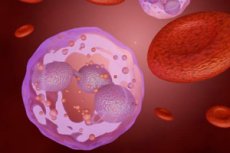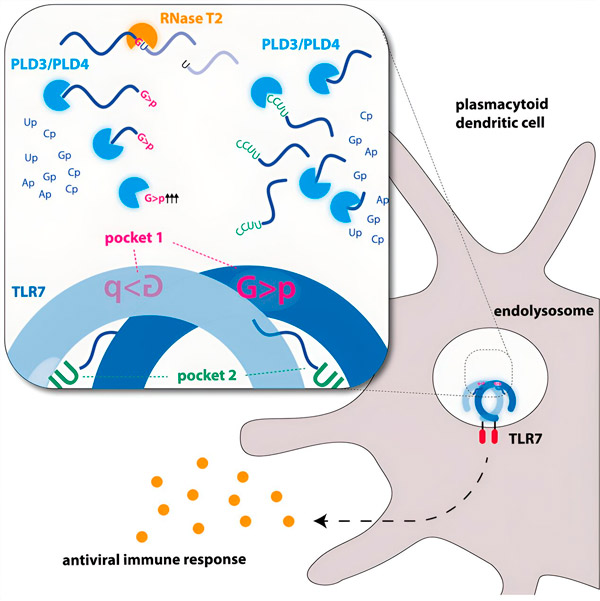
慕尼黑大学 (LMU) 的研究人员已经破译了围绕先天免疫受体 Toll 样受体 7 (TLR7) 的各种酶的复杂相互作用,TLR7 在保护我们的身体免受病毒侵害方面发挥着重要作用。
Toll样受体7 (TLR7) 位于人体免疫系统的树突状细胞上,在人体抵御病毒的天然防御机制中发挥着至关重要的作用。TLR7 能够识别单链病毒和其他外来RNA,并激活炎症介质的释放。该受体的功能障碍也在自身免疫性疾病中发挥着关键作用,因此,了解并(理想情况下)调控 TLR7 的激活机制就显得尤为重要。
由慕尼黑遗传学中心和慕尼黑大学生物化学系的Veit Hornung教授和Marlene Berouti教授领导的研究人员,对复杂的激活机制进行了更深入的研究。先前的研究显示,复杂的RNA分子必须被切割才能被受体识别。
慕尼黑大学的研究人员利用从细胞生物学到低温电子显微镜等一系列技术,揭示了单链外来RNA如何被处理以检测TLR7。他们的研究成果发表在《免疫》杂志上。
许多酶参与外来 RNA 的识别
在进化过程中,免疫系统已特化地利用遗传物质识别病原体。例如,先天免疫受体 TLR7 受到病毒 RNA 的刺激。我们可以将病毒 RNA 视为长链分子,它们太大而无法被 TLR7 的配体识别。这时,核酸酶就派上用场了——它就像分子切割工具,将“RNA 链”切割成小片段。
内切酶像剪刀一样将RNA分子从中间切开,而外切酶则将RNA链从一端切到另一端。这个过程会产生不同的RNA片段,这些片段可以与TLR7受体上的两个不同口袋结合。只有当受体上的两个结合口袋都被这些RNA片段占据时,才会触发信号级联,激活细胞并触发警报状态。

图片来源:Immunity (2024)。DOI:10.1016/j.immuni.2024.04.010
研究人员发现,TLR7 RNA识别需要内切酶RNase T2的活性,并与外切酶PLD3和PLD4(磷脂酶D3和D4)协同作用。“虽然之前已知这些酶可以降解RNA,”Hornung说,“但现在我们证明它们与TLR7相互作用并从而激活TLR7。”
平衡免疫系统
研究人员还发现,PLD核酸外切酶在免疫细胞中发挥双重作用。对于TLR7,它们具有促炎作用;而对于另一个TLR受体TLR9,它们则具有抗炎作用。“PLD核酸外切酶的这种双重作用表明,在控制正常免疫反应方面存在着精细协调的平衡,”Berouti解释说。
“这些酶同时刺激和抑制炎症可能作为防止系统功能障碍的重要保护机制。”其他酶可能在此信号通路中发挥什么作用,以及所涉及的分子是否适合作为治疗的靶标结构,将是进一步研究的主题。

